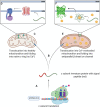C subunit of the ATP synthase is an amyloidogenic calcium dependent channel-forming peptide with possible implications in mitochondrial permeability transition
- PMID: 33888826
- PMCID: PMC8062469
- DOI: 10.1038/s41598-021-88157-z
C subunit of the ATP synthase is an amyloidogenic calcium dependent channel-forming peptide with possible implications in mitochondrial permeability transition
Abstract
The c subunit is an inner mitochondrial membrane (IMM) protein encoded by three nuclear genes. Best known as an integral part of the F0 complex of the ATP synthase, the c subunit is also present in other cytoplasmic compartments in ceroid lipofuscinoses. Under physiological conditions, this 75 residue-long peptide folds into an α-helical hairpin and forms oligomers spanning the lipid bilayer. In addition to its physiological role, the c subunit has been proposed as a key participant in stress-induced IMM permeabilization by the mechanism of calcium-induced permeability transition. However, the molecular mechanism of the c subunit participation in IMM permeabilization is not completely understood. Here we used fluorescence spectroscopy, atomic force microscopy and black lipid membrane methods to gain insights into the structural and functional properties of unmodified c subunit protein that might make it relevant to mitochondrial toxicity. We discovered that c subunit is an amyloidogenic peptide that can spontaneously fold into β-sheets and self-assemble into fibrils and oligomers in a Ca2+-dependent manner. C subunit oligomers exhibited ion channel activity in lipid membranes. We propose that the toxic effects of c subunit might be linked to its amyloidogenic properties and are driven by mechanisms similar to those of neurodegenerative polypeptides such as Aβ and α-synuclein.
Conflict of interest statement
The authors declare no competing interests.
Figures




References
Publication types
MeSH terms
Substances
Grants and funding
LinkOut - more resources
Full Text Sources
Miscellaneous

